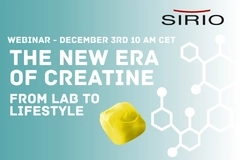Supplement trends in the US
Discover how consumers preferences and product innovation are shaping the supplements market

In the US, consumers are increasingly prioritizing their well-being and healthy lifestyles. Supplements play a vital role in filling nutritional gaps, supporting overall well-being and addressing specific health concerns. From boosting mental health to enhancing physical appearance, these products cater to diverse needs.
Innova Market Insights’ Innova360 research into supplement trends highlights the key insights shaping the US supplement industry, including consumer preferences, top brands, product launches, and the future trends likely to drive industry growth.
Supplement market size and trends
Supplement sales in the US grew steadily at 6% CAGR in the past year and are projected to continue growing at this rate until 2027. Better Being Co. (formerly Nutraceutical) and Nestlé lead among the top 10 UHCs (ultimate holding company), with each contributing 2% of the product launches over the past five years. The overall top 10 of UHCs account for 12% of the product launches during the same period.

Better Being Co., Nestlé Health Science, and The Vitamin Shoppe are leaders in US supplement innovation. Better Being Co. leads in unit market share in dietary supplements and personal care products in healthy food channels. The brand focuses on clean, traceable ingredients sourced from premium suppliers, ensuring lab-tested purity and efficacy.
Nestlé Health Science concentrates on medical nutrition while promoting lifestyle brands like Garden of Life, Osteo Bi-Flex, and Nature’s Bounty. Notably, Nature’s Bounty introduced three new products targeting women’s wellness, addressing hair growth, sexual health, and vaginal pH balance in the past year.
Top brands in supplements launches include Vital Nutrients, Nature’s Way, Bestvite, Prohealth, and Natrol in the past year.
Consumer supplement preferences
Supplements trends research indicates that 76% of consumers in the US took nutritional supplements regularly over the past year. Multivitamin/mineral supplements lead in consumption rate at 40%, followed by single vitamin supplements at 35%. Meanwhile, 70% of consumers purchase these products monthly or more frequently.
Health was a leading motivation for increased supplement consumption over the past year. Over one-quarter of consumers take supplements to boost immunity, address specific health issues, and improve sleep. Their concerns include heart health, weight management, and healthy aging. Other notable concerns are digestive, bone, brain, immune, eye, and skin health.
Consumers prefer supplements as their second option after food and beverage sources to reach their targeted nutrition goals. Their interests include maintaining mental health, gut health, and physical appearance. Vegetable is the top category sought for achieving all these goals. Supplement trends reflect consumer preferences for products targeting mental health, physical appearance, and gut health.
Supplement trends reflect consumer preferences for products targeting mental health, physical appearance, and gut health.
Supplement innovation trends
Supplement product launches increased by 1% CAGR over the past five years, with a strong growth in products offering brain/mood health, mental acuity, insomnia relief, and energy/stamina support.
Formats like gummies, powders, and capsules display positive growth, while soft gels, tablets, and liquid are in gradual reduction.
Supplement positioning trends
Supplements in the US with mental acuity claims grew at a faster rate (22% CAGR) than brain/mood health claims (12% CAGR) over the past five years. Nutraceutical and botanical ingredients, such as lion’s mane, general mushrooms, reishi mushrooms, and ashwagandha, grew in product launches with brain/mood health claims over the past two years.
Meanwhile, vitamins/minerals ingredients remained stable in supplement product launches in the same period. Products with these claims position themselves with emphasis on focus, clarity, and enhanced memory and mood.
Insomnia-related supplement launches grew steadily at 16% CAGR over the past five years. Botanical/herbal is the largest subcategory in launches with insomnia positioning followed by melatonin and vitamins/minerals.
Melatonin remains the top ingredient while ashwagandha, black pepper, chamomile extract, and reishi mushroom gained attention over the past two years. Vitamins and minerals grew in product launches, notably vitamin B6, vitamin D3, and zinc.
Supplement products with energy/stamina claims displayed 20% CAGR growth over the past five years. Ingredients, such as mushroom varieties and ginkgo biloba were noticeable, while vitamins and minerals showed a slower pace of growth in supplement products. Supplement producers can unlock new opportunities in emerging demand for healthy aging solutions.
Supplement producers can unlock new opportunities in emerging demand for healthy aging solutions.
What’s next in US supplement trends?
Supplement trends reflect consumer interest in products targeting mental health, physical appearance (such as hair, skin, nails, and weight management), and gut health. Brands can launch bundle products to meet multiple wellness needs.
Educational platforms integrated with professional and pharmaceutical resources can enhance value while offering a personalized experience.
The shift toward interactive digital solutions can continue to redefine the market. Companies can explore providing supplements with services like online consultations, intake counseling, and coaching. These services can streamline consumer efforts and support wellness goals conveniently.
Addressing emerging interests in areas like healthy aging can also create opportunities. Bundled products focusing on active lifestyles, disease prevention, and appearance maintenance can appeal to the growing senior demographic.
Transparent labeling and consumer education can further strengthen trust. Simplified, easy-to-understand product information can help consumers make informed choices.
Additionally, leveraging innovations in ingredients and formulations are likely to help brands to cater to consumers evolving needs.
This article is based on the Innova Market Insights report “Now & Next in Supplements in the US.”






















